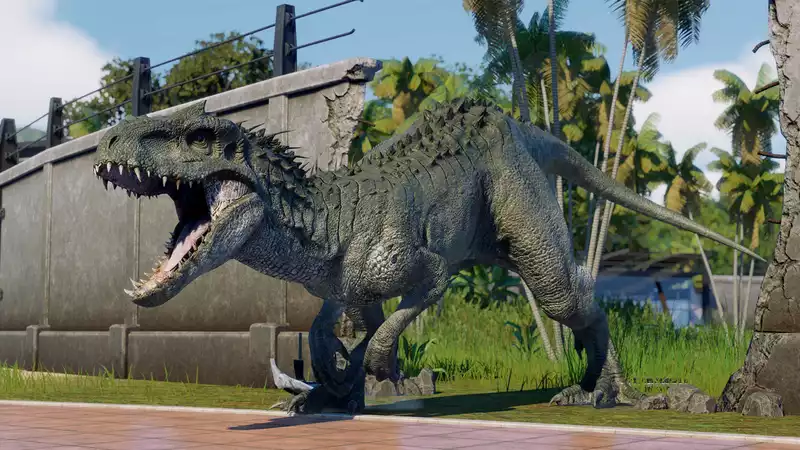Zoo Tycoon was one of my favorite games as a kid. I wasn't that interested in caring for animals, but blocking the exits with countless vending machines and unleashing an army of underfed tigers on trapped guests was never fun. Decades later, we've never been able to recreate that anarchic fun, but watching the T-Rex run amok in "Jurassic World Evolution 2" with the scientists soaring through the air is as close as we're going to get.
The premise is simple: the protagonist is charged with building and managing a series of dinosaur theme parks modeled after the movie franchise. The story of the campaign begins shortly after the events of the latest movie, Fallen Kingdom, as humanity (spoiler alert) struggles to adjust to life among recently escaped dinosaurs. Unfortunately, the entire story, consisting of five missions in all, can be completed in under two hours with time to spare, leaving little room for development in the rushed plot.
Indeed, aside from a cliffhanger ending that foreshadows the next installment, the story does little to expand on the wider world. Still, fans of the series will appreciate the dialogue, which is more than enough for Jeff Goldblum's excellent performance in his recurring role as Dr. Ian Malcolm. Bryce Dallas Howard plays Claire Dearing and several other cast members return, but their presence only accentuates Chris Pratt's absence. While Pratt's understudy does a fine job with the character of Owen Grady, his performance is subpar when juxtaposed against the original version. Whether this is a byproduct of budget constraints or scheduling conflicts, I don't know, but it is a shame that at least a couple of lines of dialogue could not be recorded with the man himself.
The lack of any sort of traditional tutorial is also noticeable, and the brief guide section during the campaign seems to have been abandoned altogether. Thankfully things were never confusing, but the lack of a quick way to learn basic mechanics makes the transition between the strictly linear campaign and the more open-ended Sandbox, Challenge, and Chaos Theory modes uncomfortable. Sandbox and Challenge need no explanation, but Chaos Theory is a shame because it is worth a look.
With a variety of "what if" scenarios based on the events of each of the five films, the first level has you creating your own Jurassic Park in an environment that perfectly mimics the original Jurassic Park. Everything has a nostalgic feel, and the setting of each mission is instantly recognizable thanks to the great care taken to preserve the unique aesthetic of the buildings from each era of the park.
The changes are not only visual, as a number of new mechanisms, such as water tanks and monorails, set the more modern setting apart from its predecessors. Also nice is the option to further tweak the look of certain dinosaurs and vehicles with a selection of unlockable skins, although not as deep as the visual customization of other "Frontier" titles.
The campaign mode focuses solely on building enclosures to house the various dinosaurs, with success increasing overall comfort. While dinosaurs can be easily satisfied by placing a few objects or quickly changing terrain types, park guests have two sets of needs to meet. These are basic needs, such as access to food and drink, and secondary needs, which are determined by which of the four categories they fall into: luxury, adventure, nature, or general. Taking luxury as an example, this type of guest demands the presence of expensive attractions such as spas and hotels.
Unfortunately, it soon became apparent that these categories are in fact largely redundant, with a few toilets, food stalls, and emergency shelters placed haphazardly, more than enough to satisfy the majority of guests. While individual guest needs are a good idea on paper, it is odd that a park can operate profitably while choosing to ignore them. There are also minor irritations here and there, such as having to manually refuel buildings every time they run out of fuel, or inconsistent collision determination that can lead to disastrous object placement.
Despite this, I always felt that the dinosaurs themselves were more than enough to hold my interest; each of the 75 or so unique dinosaur species is wonderfully modeled and beautifully animated. But the dinosaurs are at their best in those rare moments when things go wrong. While it's certainly cool to see a Velociraptor bouncing around in its cage, it's even better to see it running amok in the park, and the damage modeling on the walls and vehicles nicely emphasizes the creature's massive destructive power.
The ragdoll physics as guests traverse the map at ridiculous speeds is routinely hilarious, and the constant threat of power outages and random tropical storms breaking down enclosure walls means that even the most well-oiled park is always just moments away from catastrophe. Add to that a genetic trait system that can produce a more aggressive kind of dino if you are not careful, and you have a game that is more survival horror than traditional park tycoon.
You know that something is bound to go wrong eventually, but like watching a movie for the first time, you are on edge waiting for the inevitable to happen. As simple as the simulation elements are, this unique dynamism is one of the main reasons I recommend "Jurassic World Evolution 2."
.

Comments